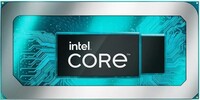Intel Core 7 240H vs Intel Core i7-14650HX vs Intel Core 5 220H
Intel Core 7 240H
► remove from comparison
The Intel Core 7 240H is a high-end mobile CPU for laptops of the Raptor Lake-H series (based on the Alder Lake architecture). It was announced in late 2024 and offers 6 performance cores (P-cores, Golden Cove architecture) and 4 of the 8 efficient cores possible (E-cores, Gracemont architecture). The P-cores support Hyper-Threading for 16 threads when combined with the E-cores. The clock rates range from 2.5 to 5.2 GHz (single-core boost) on the performance cluster and 1.8 to 4 GHz on the efficient cluster. The performance of the E-cores should be similar to old Skylake cores (comparable to the Core i7-6700HQ). All cores can use up to 24 MB L3 cache.
Compared to the older Core i7-13620H, the Core 7 240H offers higher clock speeds (especially Turbo Boost) and support for DDR5-5600.
Performance
Thanks to the improved clock speeds, the Core 7 240H should be able to slightly best the old i7-13620H. Still, the faster i7 models of the 13th gen offer more E-cores and therefore a clearly better multi-threaded performance.
Features
The integrated memory controller supports various memory types up to DDR5-5600 (up from DDR5-5200 of the 12th gen.). The Thread Director (in hardware) can help the operating system to decide which thread to use on the performance or efficient cores for the best performance. For AI tasks, the CPU also integrates GNA 3.0 and DL Boost (via AVX2). Quick Sync in version 8 is the same as in the Rocket Lake CPUs and supports MPEG-2, AVC, VC-1 decode, JPEG, VP8 decode, VP9, HEVC, and AV1 decode in hardware. The CPU now supports PCIe 5.0 x8 for a GPU and two PCIe 4.0 x4 for SSDs.
The integrated graphics adapter is based on the Xe-architecture and offers 64 of the 96 EUs (Execution Units) possible, clocked at up to 1.5GHz.
Power consumption
The Core 7 240H is rated at a TDP of 55W (PL1, 115W PL2) and is manufactured on an improved 10nm process (Intel 7) that allows for higher clock speeds compared to the 12th gen CPUs.
Intel Core i7-14650HX
► remove from comparison
The Intel Core i7-14650HX is a high-end CPU based on the new Raptor Lake architecture for large and heavy notebooks. The CPU was introduced at the beginning of 2024 and is similar to the older Core i7-13700HX except for slightly higher CPU clock rates (max 200 MHz).
The total of 24 threads are divided into P-cores and E-cores, which we already know from Alder-Lake. The 13700HX offers 8 performance cores (P-cores) with hyperthreading and 8 efficiency cores (E-cores) without hyperthreading. A total of 20 threads are therefore supported. The P-cores clock from 2.2 to 5.2 GHz (single core) or 4.5 GHz (all cores) and the E-cores from 1.6 to 3.7 GHz. The integrated memory controller supports a maximum of DDR5 with 4800 MHz (and not 5600 MHz like the i9 HX models).
Compared to Alder Lake, the new Raptor Lake architecture offers improved P-cores (Raptor Cove architecture with more cache), more E-cores (same Gracemont architecture) and higher clock rates thanks to the improved Intel 7 process. Furthermore, Intel now supports faster DDR5 main memory in the top models (up to 5600 MHz in the i9).
The performance should be slightly above the older Core i7-13700HX (with the same TDP settings and cooling). This makes the CPU ideal for demanding tasks and games.
The 14650HX continues to be manufactured using Intel's improved 10nm FinFET process (Intel 7 process) and is specified with 55 watts of base power and 157 watts of turbo power.
Intel Core 5 220H
► remove from comparison
The Intel Core 5 220H is a mid-range mobile CPU for laptops of the Raptor Lake-H refresh series (Alder Lake architecture). It was announced in late 2024 and offers 4 of the 6 performance cores possible (P-cores, Golden Cove architecture) and all 8 efficient cores (E-cores, Gracemont architecture). The P-cores support Hyper-Threading for 16 threads when combined with the E-cores. The clock rates range from 2.7 to 4.9 GHz (single core boost, all core up to 4.7 GHz) on the performance cluster and 2 to 3.7 GHz on the efficient cluster. The performance of the E-cores should be similar to old Skylake cores (comparable to the Core i7-6700HQ). All cores can use up to 18 MB L3 cache.
Compared to the similar but older Core i5-13600H, the Core 5 220H is a slightly higher clocked version.
Performance
Thanks to the higher clock speeds, the Core 5 220H can surpass the old Core i5-13600H (e.g., + 100 MHz boost).
Features
The integrated memory controller supports various memory types up to DDR5-5200. The Thread Director (in hardware) can help the operating system to decide which thread to use on the performance or efficient cores for the best performance. For AI tasks, the CPU also integrates GNA 3.0 and DL Boost (via AVX2). Quick Sync in version 8 is the same as in the Rocket Lake CPUs and supports MPEG-2, AVC, VC-1 decode, JPEG, VP8 decode, VP9, HEVC, and AV1 decode in hardware. The CPU now supports PCIe 5.0 x8 for a GPU and two PCIe 4.0 x4 for SSDs. The integrated graphics adapter is based on the Xe architecture and offers 80 of the 96 EUs (Execution Units) possible.
The CPU is rated at 45 W base power (115 W PL2) but most laptops will use a PL1 of around 60 Watt. The SoC is manufactured on an improved 10nm process at Intel, which is known as Intel 7.
| Model | Intel Core 7 240H | Intel Core i7-14650HX | Intel Core 5 220H | ||||||||||||||||||||||||||||||||||||||||||||||||||||||||||||
| Codename | Raptor Lake-H Refresh | Raptor Lake-HX Refresh | Raptor Lake-H Refresh | ||||||||||||||||||||||||||||||||||||||||||||||||||||||||||||
| Series | Intel Raptor Lake-H | Intel Raptor Lake-HX | Intel Raptor Lake-H | ||||||||||||||||||||||||||||||||||||||||||||||||||||||||||||
| Series: Raptor Lake-H Raptor Lake-H Refresh |
|
|
| ||||||||||||||||||||||||||||||||||||||||||||||||||||||||||||
| Clock | 1800 - 5200 MHz | 1600 - 5200 MHz | 2000 - 4900 MHz | ||||||||||||||||||||||||||||||||||||||||||||||||||||||||||||
| L1 Cache | 864 KB | 1.1 MB | |||||||||||||||||||||||||||||||||||||||||||||||||||||||||||||
| L2 Cache | 9.5 MB | 24 MB | 10 MB | ||||||||||||||||||||||||||||||||||||||||||||||||||||||||||||
| L3 Cache | 24 MB | 30 MB | 18 MB | ||||||||||||||||||||||||||||||||||||||||||||||||||||||||||||
| Cores / Threads | 10 / 16 6 x 5.2 GHz Intel Raptor Cove P-Core 4 x 4.0 GHz Intel Gracemont E-Core | 16 / 24 8 x 5.2 GHz Intel Raptor Cove P-Core 8 x 3.7 GHz Intel Gracemont E-Core | 12 / 16 4 x 4.9 GHz Intel Raptor Cove P-Core 8 x 3.7 GHz Intel Gracemont E-Core | ||||||||||||||||||||||||||||||||||||||||||||||||||||||||||||
| TDP | 45 Watt | 55 Watt | 45 Watt | ||||||||||||||||||||||||||||||||||||||||||||||||||||||||||||
| TDP Turbo PL2 | 115 Watt | 157 Watt | 115 Watt | ||||||||||||||||||||||||||||||||||||||||||||||||||||||||||||
| Technology | 10 nm | 10 nm | 10 nm | ||||||||||||||||||||||||||||||||||||||||||||||||||||||||||||
| max. Temp. | 100 °C | 100 °C | 100 °C | ||||||||||||||||||||||||||||||||||||||||||||||||||||||||||||
| Socket | BGA1744 | BGA1964 | BGA1744 | ||||||||||||||||||||||||||||||||||||||||||||||||||||||||||||
| Features | Thread Director | DDR4-3200/DDR5-5600 RAM, PCIe 5, Thr. Director, DL Boost, GNA, MMX, SSE, SSE2, SSE3, SSSE3, SSE4.1, SSE4.2, AVX, AVX2, BMI2, ABM, FMA, ADX, VMX, SMEP, SMAP, EIST, TM1, TM2, HT, Turbo, SST, AES-NI, RDRAND, RDSEED, SHA | Thread Director | ||||||||||||||||||||||||||||||||||||||||||||||||||||||||||||
| iGPU | Intel UHD Graphics 64EUs (Alder Lake 12th Gen) ( - 1550 MHz) | Intel UHD Graphics 770 ( - 1600 MHz) | Intel Iris Xe Graphics G7 80EUs ( - 1500 MHz) | ||||||||||||||||||||||||||||||||||||||||||||||||||||||||||||
| Architecture | x86 | x86 | x86 | ||||||||||||||||||||||||||||||||||||||||||||||||||||||||||||
| Announced | |||||||||||||||||||||||||||||||||||||||||||||||||||||||||||||||
| Manufacturer | www.intel.com | ark.intel.com | www.intel.com | ||||||||||||||||||||||||||||||||||||||||||||||||||||||||||||
| Die Size | 257 mm2 |
Benchmarks
Average Benchmarks Intel Core 7 240H → 100% n=24
Average Benchmarks Intel Core i7-14650HX → 117% n=24
Average Benchmarks Intel Core 5 220H → 87% n=24
* Smaller numbers mean a higher performance
1 This benchmark is not used for the average calculation













